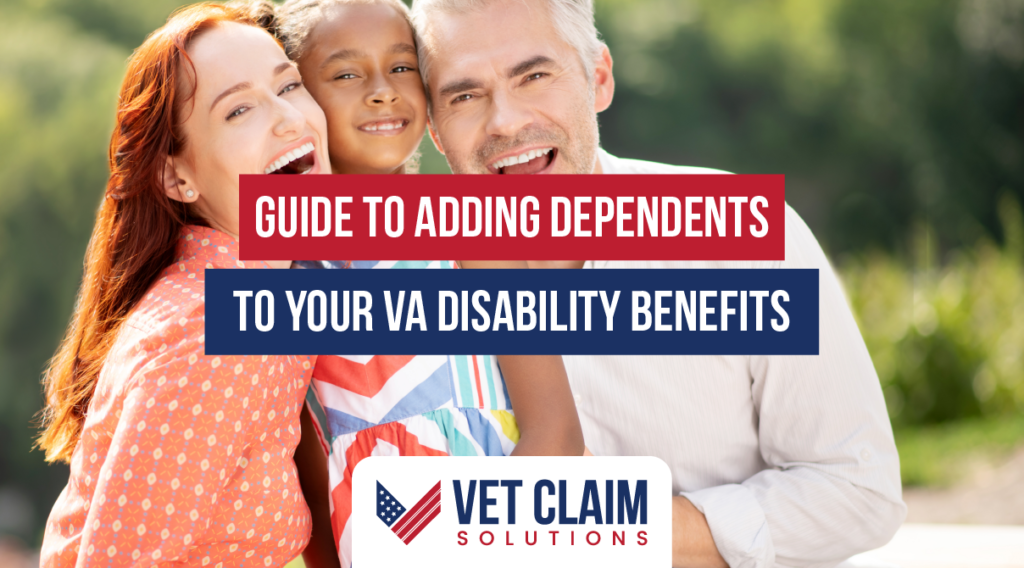Stepping into the world of VA benefits can feel like navigating a maze without a map. But, when it comes to Adding Dependents to Your VA Disability Benefits, the path becomes clearer and the rewards, more substantial. This manual illuminates the route for veterans aiming to augment their financial support by incorporating kin into their entitlement programs.
Navigating the qualifications for dependents, including spouses, offspring, and reliant parents, we’ll elucidate how this expansion not only elevates your compensation but also unveils further health care choices and educational perks for your cherished ones. By mastering this process with our step-by-step advice, you’re set up not just for immediate gains but securing future support for those closest to you.
So let’s dive in and demystify adding dependents—making sure every veteran takes full advantage of what they’ve rightfully earned.
Understanding VA Disability Benefits and Dependents
What Constitutes VA Disability?
Veterans with service-connected disabilities may qualify for VA disability compensation. This benefit hinges on a combined disability rating, reflecting the severity of their conditions. The higher this percentage, the greater the monthly payment.

A key point to note is that eligibility criteria require veterans to have a minimum combined disability rating of 30% or more to include dependents in their benefits package. Grasping these subtleties can drastically alter the level of monetary assistance you receive from Veterans Affairs.
The Impact of Adding Dependents

Add eligible dependents like spouses, children under 18 (or between 18-23 if attending school full-time), and dependent parents, could increase your monthly compensation. Each additional dependent opens up opportunities for further assistance through healthcare services, educational opportunities, employment services, and life insurance options provided by the VA’s health system.
By including dependents, such as partners, underage or schooling children, and reliant parents, families gain a crucial support system that aligns with their unique situations and requirements.
Eligibility Criteria for Adding Dependents

Recognizing Eligible Spouses
If you’re a veteran looking to add your spouse as a dependent, know that the VA recognizes marriages across the board. This includes opposite-sex and same-sex marriages, along with common-law marriages in states where they’re legally valid. But here’s something you might not know: even if your marriage doesn’t fit neatly into one of these categories, there may still be options for you.
To get more details on how different marital statuses are considered, check out how to view or change dependents on VA’s site

Children as Dependents
Having children can actually enhance the financial support you receive. Children under 18 automatically qualify, but did you catch this? If they’re between 18-23 and attending school full-time, they’re still eligible. Yes, even college students count. Make sure their school attendance is properly documented; otherwise, it’s like those late-night study sessions never happened.
This goes beyond just getting them covered under your plan—think about their future too. For more info on adding children based on their schooling status visit VA Form 21-686c instructions page.
Using eBenefits to Manage Dependent Information
Did you know that requests to add dependents via eBenefits can be processed in as little as two days? That’s right, updating your VA form or notifying the VA about a change in dependents doesn’t have to be a month-long saga.

If you’re aiming to adjust your dependent information, like adding a newborn or changing marital status, hopping onto online eBenefits is your go-to move. Crafted for veterans desiring a streamlined method to report modifications, sidestepping the hassle of extensive documentation.
This platform shines not only because it’s swift but also for its straightforwardness, making adjustments a breeze. Whether it’s time to add eligible dependents or update existing ones due to life’s inevitable changes—marriage, birth, adoption—you’re covered. The platform even guides users on how and when they should proceed with removing dependents if circumstances require it.
Comprehensive Benefits for Your Dependents

Health Care Options for Dependents
Veterans who add their dependents to VA disability claims unlock a treasure chest of benefits, starting with healthcare. These aren’t just any health services; we’re talking about comprehensive care through the VA’s family caregiver program. It means that spouses, children, and even dependent parents can get access to medical treatments without breaking the bank.
The peace of mind knowing your loved ones have healthcare coverage is priceless. But it’s not all about doctor visits and prescriptions. This coverage includes preventive care that keeps minor issues from turning into big problems down the road.

Education Benefits
If you thought healthcare was a game-changer, wait until you hear about the education benefits. The GI Bill is famous among veterans, but did you know your dependents might also tap into scholarships and training programs? Thanks to programs like those found on VA’s education benefits page, eligible family members can pursue degrees or skillsets that catapult them towards successful careers.
This isn’t merely about securing their tomorrow—it’s a beacon of hope amid adversity and a pivotal aid in realizing aspirations that once seemed unattainable.
Legal Documentation Required When Adding Dependents
Gathering the right paperwork is like assembling a puzzle; every piece must fit perfectly. To add a spouse or child as a dependent, you’ll need to dive into your filing cabinet for some crucial documents.

Gathering Necessary Documents
Common-law marriages and school attendance have their own sets of rules when it comes to VA benefits. For instance, if you’re in a common-law marriage, proving your relationship requires specific legal documentation that varies by state. And for children attending school full-time beyond high school but under 23 years old? You guessed it – more forms are needed to prove they’re still in school once they turn 18 or when circumstances change.
The backbone of this process includes birth certificates for children, marriage certificates for spouses (or relevant documents for common-law marriages), and divorce decrees if applicable. To secure the extra compensation they’re due, veterans must present these papers as verification of their eligibility. Start gathering these essentials early on and consider visiting VA Form 21P-509 page to get ahead in preparing all relevant paperwork before starting your application process.
Conclusion
Navigating VA benefits just got easier. Adding Dependents to Your VA Disability Benefits is a game-changer, offering more than just an increase in monthly compensation.
Remember the basics: spouses, children, and dependent parents can all be part of your claim. It’s not merely enhancing the present; it’s laying down a foundation for future sustenance.
Use eBenefits or specific forms—it’s streamlined and simple. Don’t forget the documents you’ll need like birth certificates or marriage licenses.
The payoff? More than higher payments. Think healthcare, education benefits, even life insurance options for your dependents.
Taking this step ensures they’re cared for long into the future. It’s practicality meeting preparation—and it starts with you making that move now.


